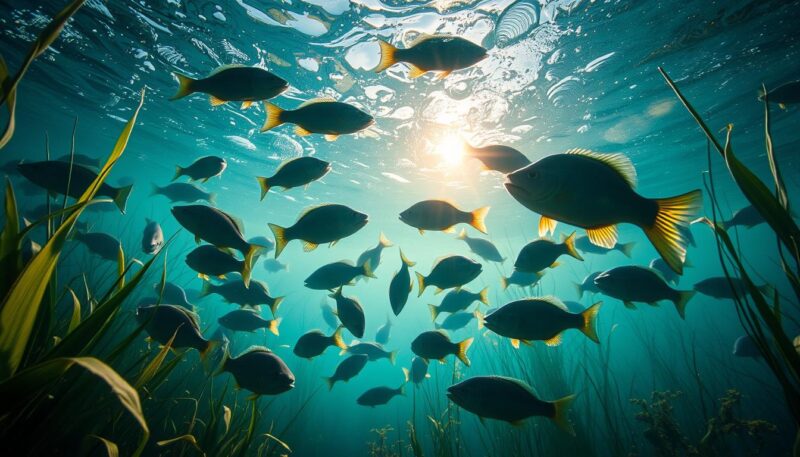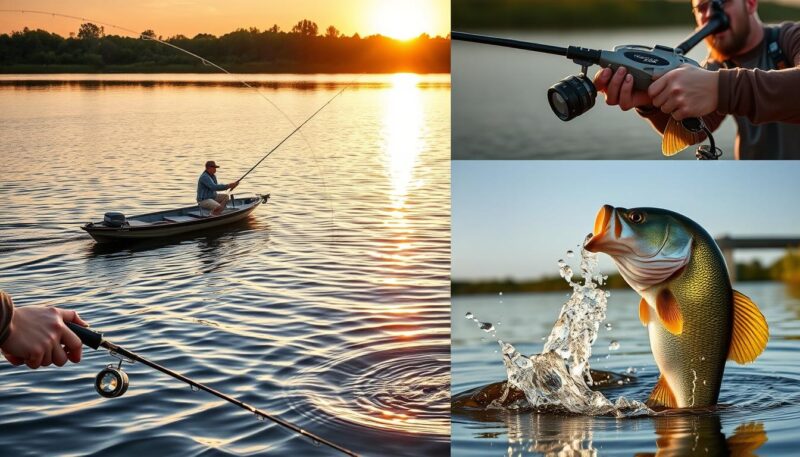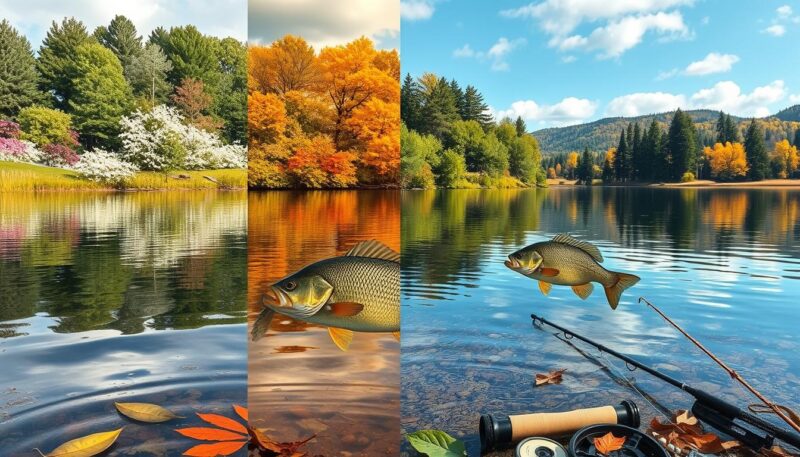For anglers eager to increase their success rate on the water, understanding the question of when are bass most active is crucial. Largemouth bass, the most fished-for freshwater gamefish in the United States, boast a wide distribution across nearly all freshwater locations in the country. Their behavior varies significantly throughout the year, influenced by factors such as water temperature and seasonal changes.
In this comprehensive guide, we will dive into bass behavior year-round, examining how temperatures impact their movement and feeding patterns. This will help you craft effective fishing strategies tailored to each season. By integrating expert insights and personal experiences, you’ll be better equipped to make the most of your time on the water and potentially land that trophy fish!
Bass Activity Throughout the Year
Bass activity throughout the year exhibits distinct seasonal patterns that significantly influence where you can find them and how actively they feed. Understanding these patterns can enhance your fishing success, allowing you to apply seasonal bass fishing tips effectively. Each season brings unique behavior and feeding characteristics that are crucial for planning your fishing trips.
Understanding Seasonal Patterns
During the winter months, bass become less active, often found at mid-depths of 15 to 20 feet. As temperatures decline below 48 degrees, their feeding opportunities also decrease. Pre-spawn activity begins in late winter, lasting for about 3 to 5 weeks, leading to a surge in feeding as bass prepare for their spawning season. Spring marks a significant shift, with water temperatures stabilizing between 60 to 65 degrees Fahrenheit, prompting bass to spawn in waves influenced by various factors like the moon phase. Early spring sees male bass actively preparing nests, while the females retreat to deeper waters after spawning is complete. Post-spawn bass appear thin and lethargic, indicating a shift in their feeding behavior.
How Water Temperature Affects Bass Behavior
Water temperature plays a pivotal role in bass feeding patterns. In summer, water temperatures may range from 75 to over 90 degrees. Optimal fishing times shift to early mornings, evenings, and nights, especially during June, which is recognized for high fishing success. The best chances to catch large bass occur when temperatures hover around 80 to 85 degrees, coinciding with heightened metabolism. As fall approaches, the drop in temperature to around 75 degrees triggers increased bass activity. This transition often leads to bass moving from deep waters to shallower areas, making them more accessible for anglers.
Importance of Seasonal Changes in Fishing Strategies
Recognizing the importance of seasonal changes enhances your ability to adapt fishing strategies throughout the year. During the winter, you may need to venture into deeper waters for a successful catch. Spring allows for more aggressive approaches as bass come into shallower areas to spawn. Summer fishing demands early morning and late evening efforts to avoid the midday heat when bass retreat to deeper waters. Fall presents a prime opportunity as bass react aggressively to baitfish schooling in shallower waters, leading to more productive fishing sessions. By understanding these seasonal responses, you can refine your methods and enhance your overall fishing experience.
When Are Bass Most Active?
Understanding when bass are active is critical for success on the water. The behavior and feeding patterns of bass fluctuate with the seasons, making it essential to adapt your bass fishing strategies accordingly. Knowing the best time to fish bass can significantly enhance your chances of making a catch.
Spring Awakening: The Pre-Spawn Period
As water temperatures reach 60°F, bass begin their pre-spawn phase, which is an exciting time to fish. During this period, bass actively seek out shallow waters near spawning sites, making it the best time to fish bass. Targeting grassy areas and structure in depths of 2 to 12 feet will yield great results. Pay attention to local environmental cues such as the blooming of flowers to time your fishing trips effectively.
Summer Strategies: Morning and Evening Feeding Frenzy
Summer presents opportunities for morning and evening fishing when bass are most active. Optimal fishing times fall between 5:30 to 8:30 a.m. and 5:00 to 7:30 p.m. As temperatures rise, bass tend to shift between shallow and deeper waters, often holding near underwater structures such as gravel beds and brush piles. Using lures like spinnerbaits and swimbaits can be particularly effective during the peak feeding times.
Fall Feeding Patterns: Preparing for Winter
Autumn signals a time for bass to feed heavily as they prepare for the colder months. During this season, bass become more active in the shallows as they look to bulk up. Fishing during low-light conditions yields better catches, and targeting weed edges or drop-offs can uncover where bass are hiding. Understanding the seasonal trends can guide your bass fishing strategies to maximize success.
Winter Fishing Techniques: Slow and Steady Approaches
Winter fishing poses challenges, yet bass remain active when water temperatures rise above 40°F. With colder waters, bass retreat to deeper areas, usually between 15 to 20 feet. Employ slower fishing techniques and deeper presentations. Focus on using electronics to locate bass, as they may become lazier in colder conditions but still feed selectively. Understanding these winter behaviors can enhance your odds of landing a trophy fish.

Bass Fishing Techniques and Strategies
Understanding effective bass fishing techniques is essential when aiming to catch active bass. Each season brings unique patterns and preferences that can significantly influence your bait selection and fishing strategies. By mastering the right techniques and knowing the optimal locations, you can maximize your fishing success throughout the year.
Effective Baits for Each Season
In spring, as bass move into shallow waters for spawning, lures that mimic local forage become highly effective. Consider using:
- Crankbaits and jigs for targeting migrations.
- Suspending jerkbaits over depth changes like points and ridges.
- Translucent finesse worms in warmer waters.
During summer, topwater lures work well at dawn and dusk, while deeper presentations like drop-shotting can target bass hiding from heat. As fall approaches, spinnerbaits and swimbaits mirror the baitfish that bass actively pursue. Switching colors frequently can enhance the chances of attracting bites.
Top Fishing Locations Based on Seasonal Activity
Identifying top fishing locations enhances your catch rates. Spring is ideal for:
- Shallow pockets and coves, particularly in wind-protected areas.
Summer requires targeting deeper structures, like submerged humps or ridges, where bass seek cooler water. In fall, focus on areas with abundant baitfish activity, while winter techniques should include searching stable submerged locations.
Adapting to Weather Conditions and Local Forage
Adaptability plays a key role in successful bass fishing. Being aware of changes in local weather can greatly influence bass behavior. Fishing tends to improve significantly before a weather front or storm. Monitoring the preferences of bass based on what they regurgitate can guide your lure choices for the day. Furthermore, bass often swim with prevailing currents, so making adjustments with respect to wind direction can boost your success rates.

Conclusion
Understanding how to catch bass year-round is essential for any fishing enthusiast looking to maximize their success. Throughout the year, bass exhibit varying levels of activity influenced by seasonal changes, water temperatures, and light conditions. By aligning your fishing strategies with these factors, especially in spring when the spawning period peaks, you will increase your chances of an enjoyable fishing experience.
In warmer months, such as summer, bass actively seek shaded areas during the heat of the day and can be more predictable during low-light conditions. As the seasons transition, it’s crucial to adapt your techniques and be patient, adapting to the natural habits of bass. The fall activity also tends to follow these patterns, emphasizing the importance of timing your fishing trips effectively.
Winter fishing may present challenges, but understanding how bass behaves in cooler temperatures can lead to success. By focusing on deeper waters during midday and employing the right techniques, you can still enjoy year-round bass fishing. Overall, keeping an eye on environmental conditions and local forage will enable you to refine your skills and make the most out of every season.

